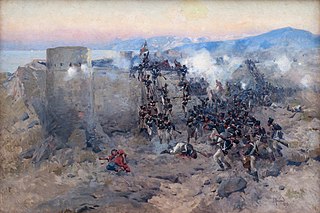 W
WThe Battle of Aslanduz took place on 31 October–1 November 1812 between Russia and Persia. The Persian Fath Ali Shah had his large army stationed in Aslanduz led by the heir to the throne, Abbas Mirza. The Russian squad, headed by the charismatic Major General Pyotr Kotlyarevsky, using the element of surprise night attack, routed the Persians who were still at sleep and quickly moved on to storm Lankaran victoriously in the beginning of 1813, thus ending any Persian hopes of continuing the war or settling on even peace terms for both parties.
 W
WThe Battle of Echmiadzin took place in June 1804, during the Russo-Persian War of 1804–1813. A Russian force of 5,000 men under Pavel Tsitsianov advanced on Erivan. An Iranian army of 20,000 under Crown-Prince Abbas Mirza met him at Echmiadzin. Cutting off the Russian's supplies the Iranians successfully defended the town and forced the Russians to withdraw. Though the Russians were unable to capture Echmiadzin, the outcome of the battle itself has been variously described as inconclusive, an Iranian victory, or a Russian victory.
 W
WThe siege of Erivan took place from July to September 1804, during the Russo-Persian War (1804–13). After a difficult advance, the Russians under Pavel Tsitsianov besieged Erivan. The Iranian forces inside Erivan's citadel prevented the Russians from making a direct attack, while those outside the citadel surrounded the Russians and cut the invaders' supply lines. Commanded by Crown-Prince Abbas Mirza and King Fath-Ali Shah Qajar himself, the Iranians successfully defended the city and defeated the Russian attack. Tsitsianov, in order to save his reputation, shifted the blame on a plethora of people and matters, and deliberately left out his own wrongdoings.
 W
WThe Siege of Erivan took place from October to November 1808, during the Russo-Persian War of 1804-1813. As in 1804, the Iranians successfully defended the city and forced the Russians to withdraw.
 W
WThe Battle of Ganja, Siege of Ganja Fortress or Assault on Ganja, was the result of a Russian offensive in the South Caucasus intended to conquer the Ganja Khanate, which contributed to the escalation of the Russo-Persian War (1804–1813).
 W
WThe Battle of Ganja or Elisavetpol took place on 26 September 1826, during the Russo-Persian War of 1826-1828.
 W
WThe Battle of Khushab took place on 7 February 1857 and was the largest single engagement of the Anglo-Persian War. Having taken Borazjan without a fight, the British expeditionary army under Sir James Outram was in the process of withdrawing to Bushehr when it was ambushed by a smaller Persian force under Khanlar Mirza, drawn up in battle order to its rear. The battle ended with a Persian victory and the withdrawal of British troops from Ahvaz, Iran.
 W
WThe Battle of Krtsanisi was fought between the Qajar Iran (Persia) and the Georgian armies of the Kingdom of Kartli-Kakheti and Kingdom of Imereti at the place of Krtsanisi near Tbilisi, Georgia, from September 8 to September 11, 1795, as part of Agha Mohammad Khan Qajar's war in response to King Heraclius II of Georgia’s alliance with the Russian Empire. The battle resulted in the decisive defeat of the Georgians, capture, and complete destruction of their capital Tbilisi, as well as the temporary absorption of eastern parts of Georgia into the Iranian Empire.
 W
WThe Siege of Lankaran took place on 1 January 1813 as part of the Russo-Persian War (1804-1813). It was noted for its bitterness and cruelty.
 W
WThe Battle of Sultanabad occurred on February 13, 1812, between the Russian Empire and Persian Empire. In the resulting battle, the Russians were routed.